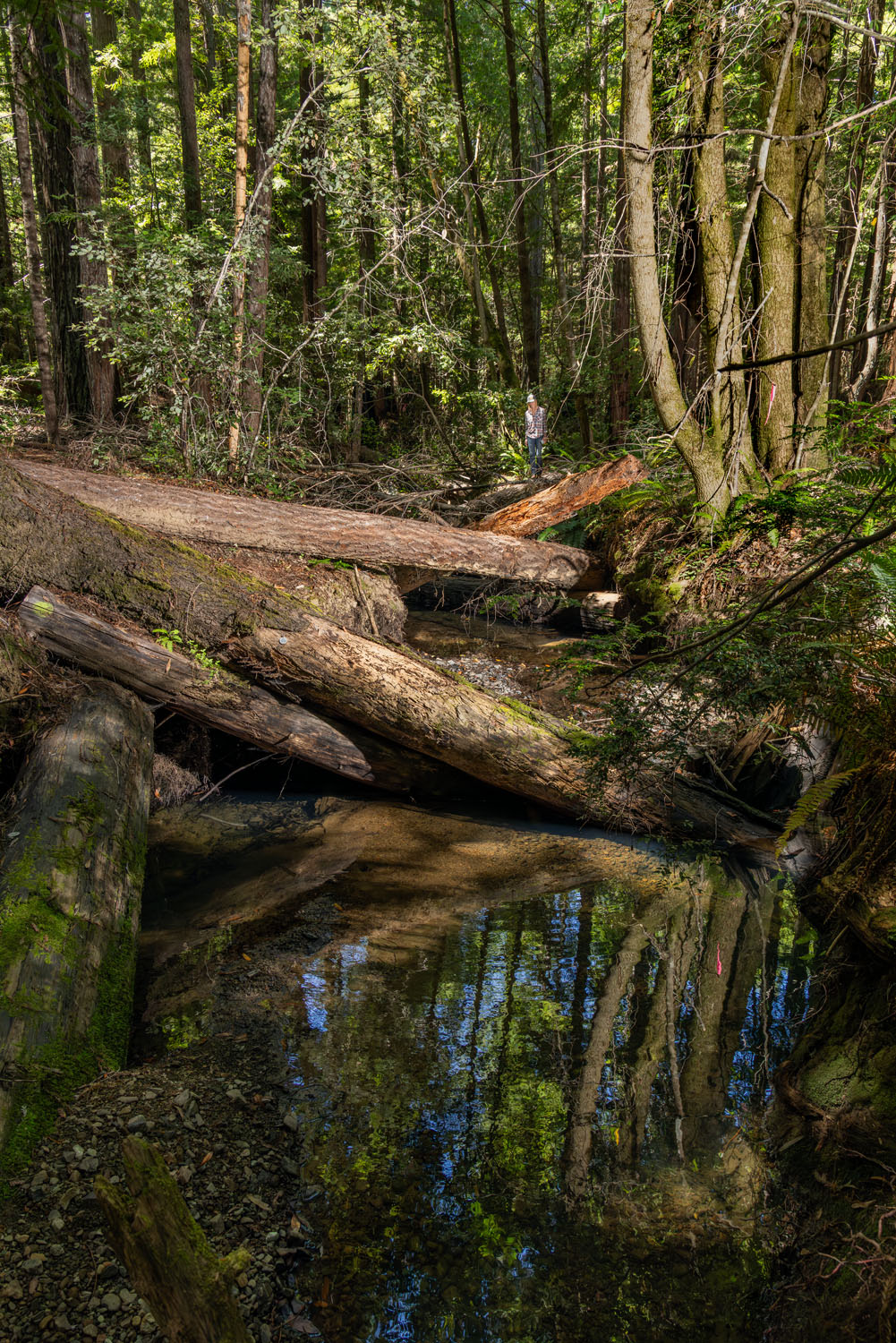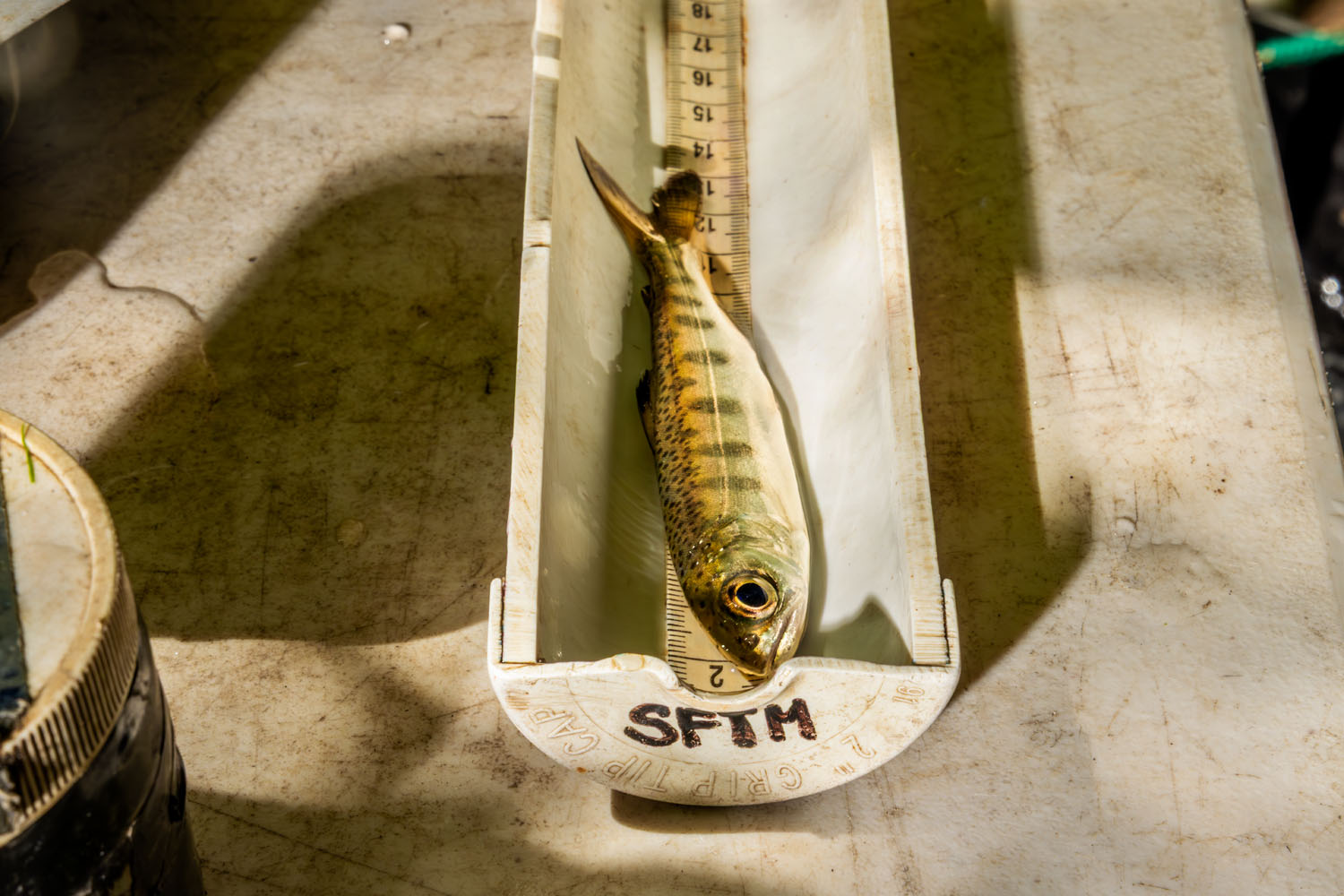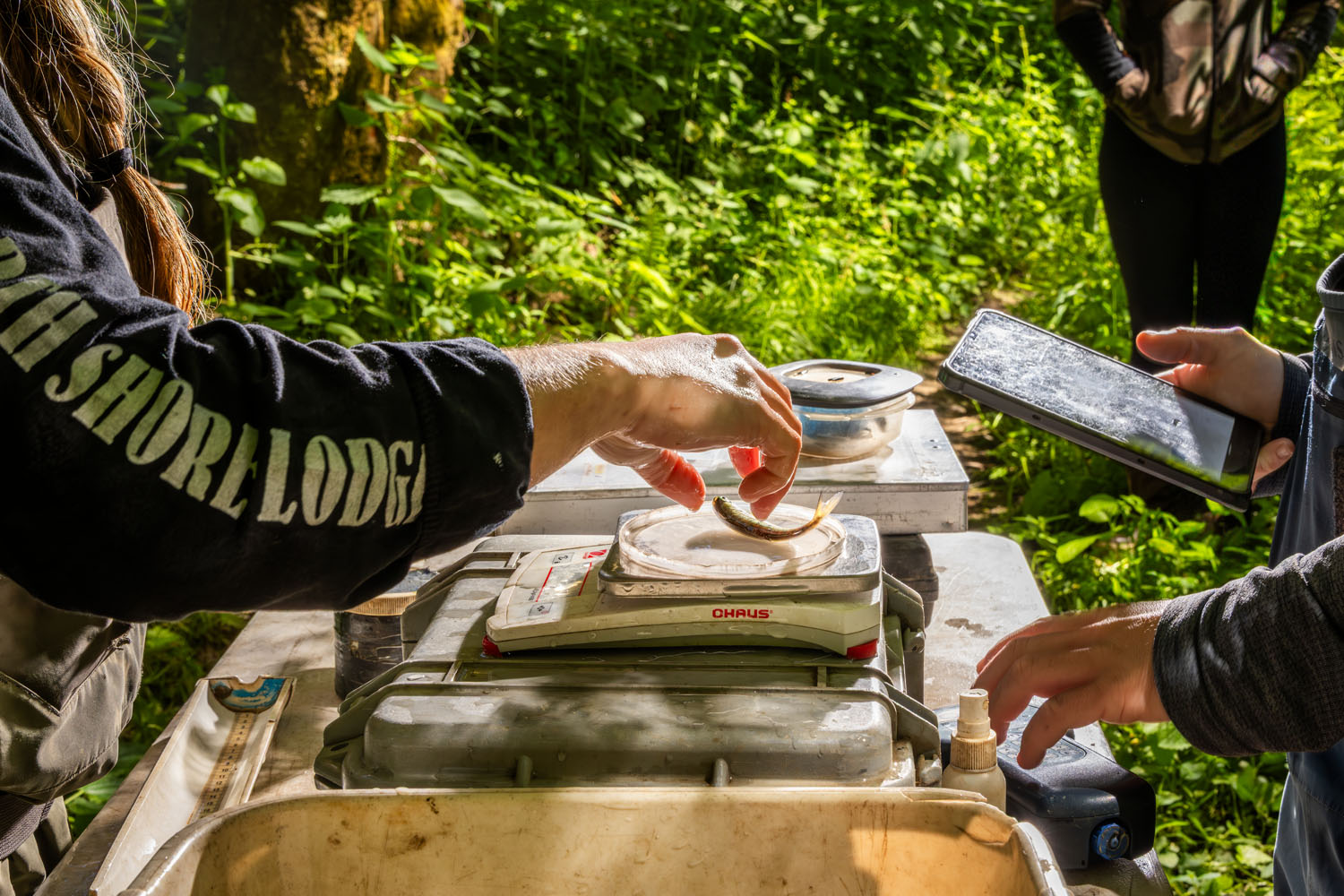Conservationists Make An (Intentional) Mess In Mendocino
Photographs by Christie Hemm Klok. This story was produced by High Country News, hcn.org, with support from Bay Nature. Conservationists restoring salmon along California’s North Coast have a mantra: A good coho salmon stream looks like a teenager’s bedroom—if teenagers discarded logs and branches instead of dirty clothes. Surveying a stretch of the Navarro River one morning last spring, Anna Halligan, a conservation biologist with Trout Unlimited, was delighted. “This is exactly what we want,” she said, examining the debris-filled water. The twigs, dirt and branches around a fallen redwood had slowed the river to a crawl and carved out a deep, sun-dappled pool underneath the trunk. In September 2020, Trout Unlimited’s partners spent days selecting a redwood and then carefully maneuvering it into the river to make it more coho-friendly. That tree has now vanished—crushed under this much larger redwood, likely carried downriver by this winter’s rains. The collision has created even more of a “mess” than Halligan could have planned. Halligan climbed down for a closer look. Within minutes, a young, silvery coho flashed into view in the new pool. The North Fork of the Navarro River is chock full of restoration projects implemented by Trout Unlimited with federal funding from NOAA. (Christie Hemm Klok) Coho salmon, which migrate between freshwater creeks and the open ocean, have nourished people, plants and animals along the Pacific Coast since time immemorial. Fred Simmons, an environmental technician for the Cahto Tribe of Laytonville Rancheria, recalled growing up along coho runs “jammed up so thick that you could go out there any time of evening and just get whatever you needed for your family.” But logging, development and climate change have devastated the coastal streams, and Simmons—now in his 60s—has seen coho pushed to the brink. The population in and around Mendocino County, toward the southern end of the species’ range, was declared threatened by the U.S. Fish and Wildlife Service in 1996 and endangered in 2005. That young coho in the Navarro River was part of a resurgence: For two years now, conservationists have watched the species return to the coast in notably large numbers. For the first time, “recovery seems possible,” said Peter Van De Burgt, a restoration manager with The Nature Conservancy. “We’re on the right track.” Fred Simmons and Anna Halligan. (Christie Hemm Klok) The first attempts to restore Mendocino’s streams for coho and other salmon began in the 1960s. Decades of logging in the area’s old-growth forests left woody debris in stream channels, creating miles-long barriers. Well-intentioned state conservationists decided to remove it. “They had this Western concept, like sweeping the floor,” said Anira G’Acha, environmental director for the Cahto Tribe of Laytonville Rancheria. They left behind hundreds of miles of tidy streams—simplified channels like bowling-alley lanes filled with fast-flowing water. And fish kept dying. “It’s hard to be a salmon,” said Van De Burgt. Everything wants to eat you—birds, otters, even other fish. Without fallen logs to slow their flow, streams lack the overhanging banks, woody debris and deep pools that young salmon need to hide from predators. Gradually, researchers realized that salmon needed the shelter provided by logjams. By the time coho salmon populations were protected by the Endangered Species Act, the California Department of Fish and Wildlife “basically did an ‘Oops’ and said, ‘Well, let’s put them back in again,’” said John Andersen, a California forester and policy director of the Mendocino and Humboldt Redwood Companies. Along the Albion River in Mendocino County, California Conservation Corps members put wood back into the river. Because the location is so remote, all the work is done by hand, with a pulley system to place the logs. (Christie Hemm Klok)Historically, fire helped fell the trees salmon needed. “Stream habitat evolved around fire for thousands of years,” said Ron Reed, a Karuk tribal member who is a cultural biologist and dipnet fisherman. But as the logging industry grew, so did wildfire suppression. Conservationists had to cut down some trees to create new logjams. In the late 1990s, Mendocino Redwood and other logging companies began partnering with Trout Unlimited to restore coho back to the land they owned; soon, The Nature Conservancy and other groups, supported by state and federal grants, began restoring streams elsewhere in the region. Halligan noted that an “ecological system” of collaborators has sustained this work, directing millions of dollars to local contractors and rural economies. But creating logjams is harder than clearing them. Projects initially went through the same state environmental permitting processes required for conventional logging projects, despite their substantially different goals. Some took more than a decade to see through. Other challenges were more practical. “We learned very quickly,” said forester Chris Blencowe, who consults on Nature Conservancy and Trout Unlimited projects. Blencowe initially relied on second-growth redwoods but noticed that when they toppled into a streambed, they would “often just break like an overweight watermelon.” He’s since switched to Douglas fir for many of his projects. Blencowe has also learned to wedge logs between standing trees so that the wood doesn’t wash away in the winter rains, as it did in the early years. The Nature Conservancy has come to rely on a machine that uses vibrations to sink logs into the sediment, since the sound of a power hammer could stun or kill nearby fish. Even after 20 years, not everything goes according to plan. Van De Burgt said this unpredictability is a feature, not a bug: “We want to implement projects that create chaos in the river.” The more chaos, the more places young coho will have to live and survive—and the more coho will make their way downstream to the ocean. The projects can benefit other salmon and steelhead species, too, as well as the streamside forests. Felling nearby second-growth trees for logjams “encourages understory plant relatives to grow,” Marisa McGrew, a Karuk and Yurok woman and assistant natural resources director for the Wiyot Tribe, said over email. “Stream restoration and forest restoration go hand in hand.” Bay Nature’s email newsletter delivers local nature stories, hikes, and events to your inbox each week. Sign up today! On the 10 Mile River in Mendocino County, biologists Lydia Brown and Evan Broberg insert PIT (Passive Integrated Transponder) tags into the underside of juvenile coho salmon, which allows them to track its growth for its lifetime. (Christie Hemm Klok)In the winter of 2023-2024, 15,000 coho salmon returned to spawn along the Mendocino coast, the highest number recorded by the California Department of Fish and Wildlife in 16 years of monitoring the population. Last winter, according to preliminary estimates, that number nearly doubled. “I think we got the perfect alignment,” said Sarah Gallagher, who leads the agency’s monitoring program. Good ocean conditions, a reprieve from several years of drought, and hundreds of miles of restored streams have combined to foster a flush of coho. Still, this recovering population represents a fraction of historic runs. Once, hundreds of thousands of coho returned to California streams each year. But chinook and steelhead continue to dwindle. In mid-April, the interstate Pacific Fishery Management Council extended its ban on ocean salmon fishing for a third year. And hundreds more miles of North Coast streams still need wood. “Sometimes, when you look at it on a map, it looks like we’ve barely done anything at all,” said Halligan of Trout Unlimited. Even as this year’s population is tallied, its habitat’s future is uncertain. Earlier this year, the Trump administration proposed deep cuts to the budget of the National Oceanic and Atmospheric Administration, whose Pacific Coastal Salmon Recovery Fund has supported much of the restoration work along with Gallagher’s coho monitoring. Meanwhile, Northern California conservationists are exploring alternatives, such as the $10 billion for climate resilience projects in Proposition Four, which California voters approved last November. With recovery underway, they’re determined to continue bringing coho back. The coho “are realizing this is their homeland where they were born,” Simmons said. “It seems like they’re trying to heal.” Christie Hemm Klok is a San Francisco-based photojournalist. She is passionate about storytelling that highlights the relationship between nature and humans. This story is part of High Country News’s Conservation Beyond Boundaries project, which is supported by the BAND Foundation. Water reflections on the Navarro River, in the dappled light of the forest. (Christie Hemm Klok)
And coho salmon love it. The post Conservationists Make An (Intentional) Mess In Mendocino appeared first on Bay Nature.
Photographs by Christie Hemm Klok. This story was produced by High Country News, hcn.org, with support from Bay Nature.
Conservationists restoring salmon along California’s North Coast have a mantra: A good coho salmon stream looks like a teenager’s bedroom—if teenagers discarded logs and branches instead of dirty clothes. Surveying a stretch of the Navarro River one morning last spring, Anna Halligan, a conservation biologist with Trout Unlimited, was delighted. “This is exactly what we want,” she said, examining the debris-filled water. The twigs, dirt and branches around a fallen redwood had slowed the river to a crawl and carved out a deep, sun-dappled pool underneath the trunk.
In September 2020, Trout Unlimited’s partners spent days selecting a redwood and then carefully maneuvering it into the river to make it more coho-friendly. That tree has now vanished—crushed under this much larger redwood, likely carried downriver by this winter’s rains. The collision has created even more of a “mess” than Halligan could have planned.
Halligan climbed down for a closer look. Within minutes, a young, silvery coho flashed into view in the new pool.

Coho salmon, which migrate between freshwater creeks and the open ocean, have nourished people, plants and animals along the Pacific Coast since time immemorial. Fred Simmons, an environmental technician for the Cahto Tribe of Laytonville Rancheria, recalled growing up along coho runs “jammed up so thick that you could go out there any time of evening and just get whatever you needed for your family.”
But logging, development and climate change have devastated the coastal streams, and Simmons—now in his 60s—has seen coho pushed to the brink. The population in and around Mendocino County, toward the southern end of the species’ range, was declared threatened by the U.S. Fish and Wildlife Service in 1996 and endangered in 2005.
That young coho in the Navarro River was part of a resurgence: For two years now, conservationists have watched the species return to the coast in notably large numbers. For the first time, “recovery seems possible,” said Peter Van De Burgt, a restoration manager with The Nature Conservancy. “We’re on the right track.”
Fred Simmons and Anna Halligan. (Christie Hemm Klok)
The first attempts to restore Mendocino’s streams for coho and other salmon began in the 1960s. Decades of logging in the area’s old-growth forests left woody debris in stream channels, creating miles-long barriers. Well-intentioned state conservationists decided to remove it.
“They had this Western concept, like sweeping the floor,” said Anira G’Acha, environmental director for the Cahto Tribe of Laytonville Rancheria. They left behind hundreds of miles of tidy streams—simplified channels like bowling-alley lanes filled with fast-flowing water.
And fish kept dying. “It’s hard to be a salmon,” said Van De Burgt. Everything wants to eat you—birds, otters, even other fish. Without fallen logs to slow their flow, streams lack the overhanging banks, woody debris and deep pools that young salmon need to hide from predators.
Gradually, researchers realized that salmon needed the shelter provided by logjams. By the time coho salmon populations were protected by the Endangered Species Act, the California Department of Fish and Wildlife “basically did an ‘Oops’ and said, ‘Well, let’s put them back in again,’” said John Andersen, a California forester and policy director of the Mendocino and Humboldt Redwood Companies.

Historically, fire helped fell the trees salmon needed. “Stream habitat evolved around fire for thousands of years,” said Ron Reed, a Karuk tribal member who is a cultural biologist and dipnet fisherman. But as the logging industry grew, so did wildfire suppression. Conservationists had to cut down some trees to create new logjams.
In the late 1990s, Mendocino Redwood and other logging companies began partnering with Trout Unlimited to restore coho back to the land they owned; soon, The Nature Conservancy and other groups, supported by state and federal grants, began restoring streams elsewhere in the region. Halligan noted that an “ecological system” of collaborators has sustained this work, directing millions of dollars to local contractors and rural economies.
But creating logjams is harder than clearing them. Projects initially went through the same state environmental permitting processes required for conventional logging projects, despite their substantially different goals. Some took more than a decade to see through.
Other challenges were more practical. “We learned very quickly,” said forester Chris Blencowe, who consults on Nature Conservancy and Trout Unlimited projects. Blencowe initially relied on second-growth redwoods but noticed that when they toppled into a streambed, they would “often just break like an overweight watermelon.” He’s since switched to Douglas fir for many of his projects.
Blencowe has also learned to wedge logs between standing trees so that the wood doesn’t wash away in the winter rains, as it did in the early years. The Nature Conservancy has come to rely on a machine that uses vibrations to sink logs into the sediment, since the sound of a power hammer could stun or kill nearby fish.
Even after 20 years, not everything goes according to plan. Van De Burgt said this unpredictability is a feature, not a bug: “We want to implement projects that create chaos in the river.” The more chaos, the more places young coho will have to live and survive—and the more coho will make their way downstream to the ocean.
The projects can benefit other salmon and steelhead species, too, as well as the streamside forests. Felling nearby second-growth trees for logjams “encourages understory plant relatives to grow,” Marisa McGrew, a Karuk and Yurok woman and assistant natural resources director for the Wiyot Tribe, said over email. “Stream restoration and forest restoration go hand in hand.”
Bay Nature’s email newsletter delivers local nature stories, hikes, and events to your inbox each week.
Sign up today!

In the winter of 2023-2024, 15,000 coho salmon returned to spawn along the Mendocino coast, the highest number recorded by the California Department of Fish and Wildlife in 16 years of monitoring the population. Last winter, according to preliminary estimates, that number nearly doubled. “I think we got the perfect alignment,” said Sarah Gallagher, who leads the agency’s monitoring program. Good ocean conditions, a reprieve from several years of drought, and hundreds of miles of restored streams have combined to foster a flush of coho.
Still, this recovering population represents a fraction of historic runs. Once, hundreds of thousands of coho returned to California streams each year. But chinook and steelhead continue to dwindle. In mid-April, the interstate Pacific Fishery Management Council extended its ban on ocean salmon fishing for a third year. And hundreds more miles of North Coast streams still need wood. “Sometimes, when you look at it on a map, it looks like we’ve barely done anything at all,” said Halligan of Trout Unlimited.
Even as this year’s population is tallied, its habitat’s future is uncertain. Earlier this year, the Trump administration proposed deep cuts to the budget of the National Oceanic and Atmospheric Administration, whose Pacific Coastal Salmon Recovery Fund has supported much of the restoration work along with Gallagher’s coho monitoring.
Meanwhile, Northern California conservationists are exploring alternatives, such as the $10 billion for climate resilience projects in Proposition Four, which California voters approved last November. With recovery underway, they’re determined to continue bringing coho back. The coho “are realizing this is their homeland where they were born,” Simmons said. “It seems like they’re trying to heal.”
Christie Hemm Klok is a San Francisco-based photojournalist. She is passionate about storytelling that highlights the relationship between nature and humans. This story is part of High Country News’s Conservation Beyond Boundaries project, which is supported by the BAND Foundation.


